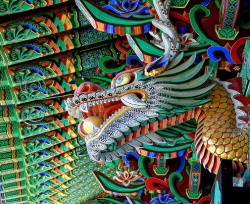Korean dragon
Korean dragons are legendary creatures in Korean mythology and folklore. The appearance of the dragon reflects its influences from its counterpart, the Chinese dragon.
Korean dragons
Whereas most dragons in European mythology are generally related to the elements of fire and destruction, dragons in Korean mythology are mostly viewed as benevolent beings related to water and agriculture, often considered bringers of rain and clouds. Hence, many Korean dragons are said to have resided in rivers, lakes, oceans, or even deep ponds within mountains.
The symbol of the dragon has been used extensively, both in Korean mythology and ancient Korean art.
Ancient texts sometimes mention sentient speaking dragons, capable of understanding such complex emotions such as devotion, kindness, and gratitude. One particular Korean legend speaks of the great King Munmu, who on his deathbed wished to become a "Dragon of the East Sea in order to protect Korea".
The Korean dragon was said to have certain specific traits, generally like the Chinese dragon, but it developed a longer beard. It is in many ways very similar in appearance to dragons of Chinese and Japanese mythology.
Very occasionally a dragon may be depicted as carrying a dragon orb known as the Yeouiju (여의주) in one or more of its claws or in its mouth. Modeled after the mythical Cintamani jewel or pearl, it was said that whoever could wield the Yeouiju was blessed with the abilities of omnipotence and creation at will, and that only four-toed dragons (who had thumbs with which to hold the orbs) were both wise and powerful enough to wield these orbs, as opposed to the lesser, three-toed dragons.
As with China, the number nine is significant and auspicious in Korea, and dragons were said to have 81 (9×9) scales on their backs, representing yang essence.
Korean folk mythology states that most dragons were originally Imugis, or lesser dragons, which were said to resemble gigantic serpents. Koreans thought that an Imugi could become a true dragon, or yong/mireu, if it caught a Yeouiju which had fallen from heaven.
Korean cockatrice
The Korean cockatrice is known as a gye-ryong (계룡/鷄龍), which literally means chicken-dragon; they do not appear as often as dragons. They are sometimes seen as chariot-pulling beasts for important legendary figures or for the parents of legendary heroes. One such legend involves the founding of the Kingdom of Silla, whose princess was said to have been born from a cockatrice egg.
